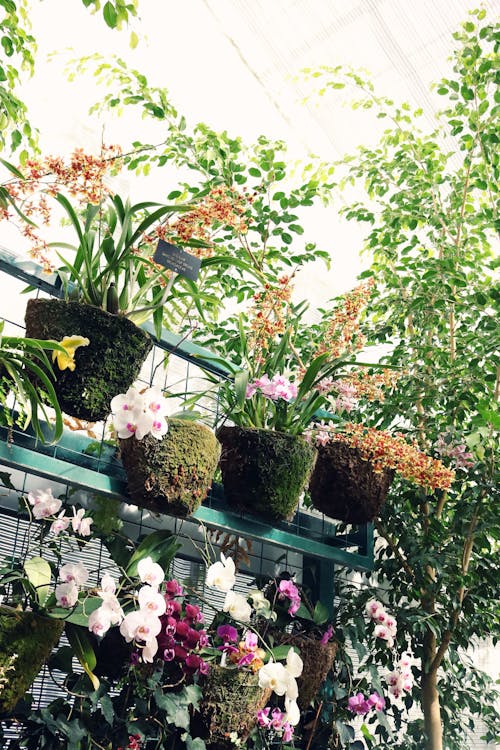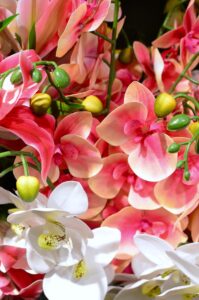Do you have a yard that doesn’t get much light to grow something? Things get difficult during the winter season? Don’t worry; you can still maintain your orchids in a good manner by using artificial lights, because When it comes to growing house plants and orchids…. light matters! Orchid indoor growing must be a fascinating and amazing experience due to the different colors and shapes of flowers blooming in the garden. Some people, growing orchids as a hobby, and some grow for professional purposes. The attraction ad beauty of the flowers, the different variety of habitats, and their different species lead to learning more about planting, and you always try to keep different varieties of flower in your orchid. Here is a good resource to help you to know about orchids? What amount of light is required? And how to grow orchids under artificial light?

So let’s get started,
About Orchids
Orchidaceae belongs to the orchid family; it is the largest flowering plant species that contain 20000 different plants for indoor cultivation, which is four times higher than mammals species. It grows best on trees, rocks and feeds on detritus around the plant roots, Although some orchids are terrestrial, epiphytic, or lithophytic. In the past indoor orchids grow on natural light, which gives them a hard time growing. However, orchids easily grow under artificial light such as LEDs. This means you can grow orchids in any place of your house to make them beautiful.

Amount of Light…
To grow orchids by using artificial light is not complicated at all, you know that what you want to grow, then you can go so far like some orchid required light in supplemented form because sometimes indoor light is not enough for them now the question arises how much light specifically your orchid required?
Many people who use artificial light to grow orchids set timers to ensure that every plant gets enough light according to their needs. Many timers follow sun directions on and off. Generally, every plant needs 14 to 16 hours of light in summers while 12 to 14 hours light during winters. Give extra light to your plant is not good at all, and totally up to you what amount of light you give to your plant.
It is also important to remember to give the maximum amount of water to your plant because artificial light may burn your plant if it does not get enough water. After that, you have to maintain its temperature, humidity, and ventilation properly.
Basic Orchid Light Requirements
If you grow your orchid outdoor, then it receives all spectrum of sunlight and all nonvisible light. Many industries produced bulb and horticultural products to fulfill all the requirements of botanist and their plants.
They create only two types of bulbs according to their wavelength because many botanist research shows that only these two types of light affect the growth of orchids rather than another color of light.
These two lights are the red and blue wavelength of light in which red is good for flowering while blue is good for vegetative growth in your orchid.
Artificial light to grow your orchid:
Artificial light may work better than natural light because you can control its intensity and heat on everyday needs. Orchids best grow in the low and medium intensity of light. While orchid on high intensity does not grow well because it is hard to replicate the intensity of light
Artificial light sources allow you to grow orchids without using greenhouses or strong window sun rays. You can grow any plant in artificial light. There are only two restrictions towards your plan, which are equipment cost and electricity bill.
Orchids that like fluorescent bulbs:
According to botanist research, natural light is best for your orchid growth but not direct sunlight. Research reveals that early morning and late afternoon light is best for your orchid growth, but if you fail to gather sufficient sunlight, use fluorescent bulbs, which is a good complement for low light orchids and a strong partner of artificial light.
Fluorescent lights are sufficient for low-light orchids, like:
- Phalaenopsis (Moth orchids)
- Paphiopedilum,
- Militoniopsis (or Pansy orchids) and Nelly Isles.
Led grow lights for Orchids
In advanced gardening, the recent LED glowing bulb is most popular for all kinds of indoor cultivation. Its ability to form the required spectrum and sufficient energy is appropriate for indoor cultivation, commercially or as a hobbyist.
The best-LED bulbs are those that give full-spectrum under white light, not just in individual wavelengths as with some of the lower end LEDs
High-Intensity Discharge (HID)
HID lights are more powerful than LED grow lights. It can grow a large display in an empty room. Orchids like Vandya or Dendrobium will grow under HID lighting. Metal Halides is the intensity of light that gives a better match for the tropical sun. Supplemental High-Pressure Sodium (HPS provides the full spectrum of light but carries more red end lightly with a peak around 570 nm and virtually no blue light at all. A typical MH lamp will peak at around 450nm to 500nm and provide wide coverage on either side of this peak.
How much light is too much?
Remember, a simple and easy method does not require any calculation, and it gives you an accurate result. Place your hand in the path of sunlight just 6 inches above the leave and observe the shadow. If you detect the shadow perfectly then, your light is too strong, and if your shadow is not as sharp but traceable, then it’s an ideal place, and if your shadow is a blur with an undefined outline, then your light is too weak
Some referenced you can buy for indoor plant lights:
GHodec 4-Head Grow Light with Stand
Conclusion
To place light-loving plants indoors is always challenging, especially when plants required sufficient amount of light per day. Luckily, lack of light to grow your loving plant is not a problem.The LED grow lights easily available in the market with full spectrum, same as natural light. Remember that some orchids are rare and need extra care, so If you plan to buy orchids from Amazon and other internet sites, ensure that you choose easily tradable ones and not harmfully or unsustainably collected.

